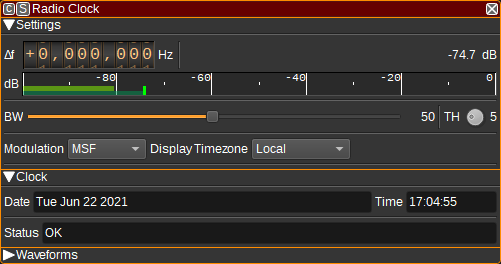3.4 KiB
Radio clock plugin
Introduction
This plugin can be used to receive the time and date as broadcast on Low Frequency (LF) by various transmitters that are tied to atomic clocks:
If you'd like other transmitters to be supported (such as WWVB), please upload a .sdriq file to SDRangel's github issue tracker.
Typically, it will take two minutes before the time is able to be displayed (up to one minute to find the minute marker, then another minute to receive the timecode).
Although the atomic clocks used to transmit the timecode are extremely accurate, propagation, SDR data transfer and demodulation delays limit accuracy of the displayed time to around 1 second, although if you receive multiple clocks simultaneously, they are all fairly synchronous.
Interface
1: Frequency shift from center frequency of reception
Use the wheels to adjust the frequency shift in Hz from the center frequency of reception. Left click on a digit sets the cursor position at this digit. Right click on a digit sets all digits on the right to zero. This effectively floors value at the digit position. Wheels are moved with the mousewheel while pointing at the wheel or by selecting the wheel with the left mouse click and using the keyboard arrows. Pressing shift simultaneously moves digit by 5 and pressing control moves it by 2.
2: Channel power
Average total power in dB relative to a +/- 1.0 amplitude signal received in the pass band.
3: Level meter in dB
- top bar (green): average value
- bottom bar (blue green): instantaneous peak value
- tip vertical bar (bright green): peak hold value
4: BW - RF Bandwidth
This specifies the bandwidth of a LPF that is applied to the input signal to limit the RF bandwidth.
5: TH - Threshold
For MSF and DCF77, specifies the threshold in dB below the average carrier power level that determines a binary 0 or 1.
6: Modulation
Specifies the modulation and timecode encoding used:
- MSF - OOK (On-off keying)
- DCF77 - OOK (On-off keying)
- TDF - PM (Phase modulation)
7: Display Timezone
Specifies the timezone used to display the received time. This can be:
- Broadcast - the time is displayed as broadcast (which is typically the timezone of the country the signal is broadcast from, adjusted for summer time).
- Local - the time is converted to the local time (as determined by your operating system's timezone).
- UTC - the time is converted to Coordinated Universal Time.
8: Date
Displays the decoded date.
9: Time
Displays the decoded time, adjusted for the timezone set by (7).
10: Status
Displays the demodulator status. This can be:
- Looking for minute marker - Indicated at startup or after signal lost, while looking for the minute marker.
- Got minute marker - Indicated after finding the minute marker and waiting for the first timecode to be received.
- OK - Indicates timecodes are being received.
The date and time fields are only valid when the status indicates OK.
If while in the OK state several second markers are missed, the status will return to Acquiring Signal.
